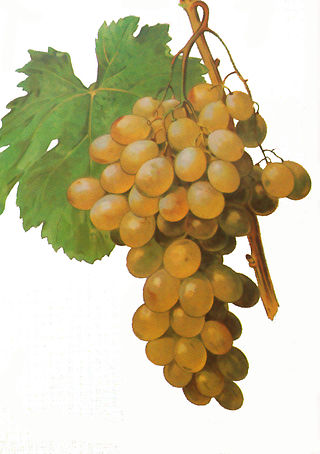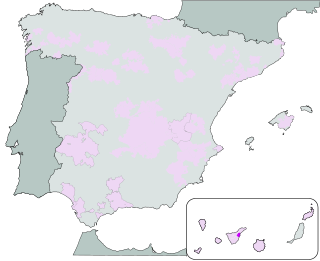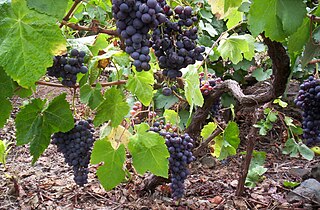Related Research Articles

Malvasia, also known as Malvazia, is a group of wine grape varieties grown historically in the Mediterranean region, Balearic Islands, Canary Islands and the island of Madeira, but now grown in many of the winemaking regions of the world. In the past, the names Malvasia, Malvazia, and Malmsey have been used interchangeably for Malvasia-based wines; however, in modern oenology, "Malmsey" is now used almost exclusively for a sweet variety of Madeira wine made from the Malvasia grape. Grape varieties in this family include Malvasia bianca, Malvasia di Schierano, Malvasia negra, Malvasia nera, Malvasia nera di Brindisi, Malvasia di Candia aromatica, Malvasia odorosissima, and a number of other varieties.

Torrontés is a white grape variety, mostly produced and known in Argentina, producing fresh, aromatic wines with moderate acidity, smooth texture and mouthfeel as well as distinctive peach and apricot aromas on the nose. Three Torrontés varieties exist in Argentina: Torrontés Riojano, the most common, Torrontés Sanjuanino, and Torrontés Mendocino. It is primarily Torrontés Riojano that has received attention for the quality of its wines, and is the variety used for most Argentine wines simply labeled Torrontés.

Muscat of Alexandria is a white wine grape that is a member of the Muscat family of Vitis vinifera. It is considered an "ancient vine", and wine experts believe it is one of the oldest genetically unmodified vines still in existence. The grape originated in North Africa, and the name is probably derived from its association with Ancient Egyptians who used the grape for wine making. It is also a table grape used for eating and raisins.

Tacoronte-Acentejo is a Spanish Denominación de Origen Protegida (DOP) for wines located in the Anaga Peninsula on the northeastern coast of the island of Tenerife. It was the first region in the Canary Islands to acquire DO status, in 1992. It covers the municipalities of Santa Cruz de Tenerife, San Cristóbal de La Laguna, El Rosario, Tegueste, Tacoronte, El Sauzal, La Matanza de Acentejo, La Victoria de Acentejo and Santa Úrsula.

Abona is a Spanish Denominación de Origen Protegida (DOP) for wines located on the southern coastline of Tenerife,, and acquired its DO in 1996.
Robola is a white Greek wine grape variety that is grown primarily on the Ionian island of Cephalonia. Historically the vine was thought to be the same variety as the Friuli wine grape Ribolla and was thought to have been brought to northeast Italy by Venetian merchants trading with Cephalonia in the 13th century. However, DNA profiling in the 21st century has cast doubt on that theory and today Robola is classified by the Vitis International Variety Catalogue (VIVC) as a separate variety.

Fiano is a white Italian wine grape variety that is grown primarily in the Campania region of southern Italy and on the island of Sicily. In Campania, this fairly strong flavored white wine grape is particularly noted around Avellino where the Denominazione di origine controllata e Garantita (DOCG) wine of Fiano di Avellino is produced. The grape has a long history in the Campanian region and is believed to have been the grape behind the ancient Roman wine Apianum. Even today, the name Apianum is permitted to appear on wine labels of the DOCG wine Fiano di Avellino.

Cayetana blanca, also known as Cayetana or Jaén, is a white Spanish wine grape. It is grown mainly in the south of Spain, especially in Extremadura and in the Jerez region where it is distilled for use in brandy production.

Alfrocheiro Preto is a red Portuguese wine grape variety planted primarily in the Dão DOC and Alentejano VR. The grape is known for the deep coloring it can add to wine blends. Under the name Baboso negro, it is considered a minor Spanish red grape variety, growing mainly in the provinces of Zamora and Salamanca, in the region of Castile and León. It is one of the authorized varieties of the La Gomera and El Hierro Denominación de Origen, in the Canary Islands (Spain).
Limnio (LIM-nee-oh) is a red Greek wine grape variety that is indigenous to the Greek island of Lemnos. The grape has had a long history of wine production that may extend back to Ancient Greece with wine historians widely believing it was the grape variety, Lemnia, that was described by Aristotle as producing the famous red Lemnian wine. According to wine expert Oz Clarke, Limnio is "One of Greece's most important red vines."

Valle de Güímar is a Spanish Denominación de Origen Protegida (DOP) for wines located along the south-eastern coastline of Tenerife, and acquired its DO in 1996.

La Gomera is a Spanish Denominación de Origen Protegida (DOP) for wines that covers the entire island of La Gomera comprising the six municipalities of San Sebastián de la Gomera, Hermigua, Agulo, Vallehermoso, Valle Gran Rey and Alajeró. It obtained its official status in 2009.

La Palma is a Spanish Denominación de Origen Protegida (DOP) for wines that covers the entire island of La Palma, in the Canary Islands, Spain. It acquired its DO in 1994. There are around 600 ha of vineyards registered with the DOP, planted in a strip along the coast, though the altitude can vary between 200 m and 1,500 m above sea-level. The DOP is divided into three sub-zones.

Listán Negro is a red Spanish wine grape variety that is widely planted in the Canary Islands, particularly on the island of Tenerife where it is a permitted variety in the Denominaciones de Origen (DO) wines of Tacoronte-Acentejo, Valle de la Orotava, Ycoden-Daute-Isora, and Valle de Güímar. It is also permitted in the Spanish wine regions of El Hierro, Gran Canaria, La Gomera, La Palma, Lanzarote. More than 5,000 hectares of the Listán Negro grape variety are planted across the Canary Islands.
Listán Prieto is a red grape variety that is believed to be originated from the Castilla-La Mancha region in Spain. Listán Prieto has disappeared from Spain mainland, but there are still 29 ha planted on the Canary Islands in 2008.
Arilla is a white Italian wine grape variety that is grown on the island of Ischia in the Tyrrhenian Sea near the Gulf of Naples. However, despite being exclusively found on the island, ampelographers believe that the grape may have actually originated in Sicily.

The Sumoll is a black grape variety. It is a rustic variety, native from the Penedès region in Catalonia (EU), drought resistant and with uniform development. The grape is long and big. It is used to produce red, white, rosé wines and Cava. Its former presence is also evident in the number of different names in Catalan dialects: sumoi, chimoi, saumoll, somoi, sumoy, ximoll, somoll, ximoy, xemoll, among others.
Forastera is a white Italian wine grape variety that is grown on the islands of Ischia and Procida off the coast of Naples in Campania. In the early 21st century, DNA analysis confirmed that the Spanish wine grape variety of the same name grown in the Canary Islands is a completely different and distinct variety with no close genetic relationship to the Italian Forastera.
Forastera is the primary name or synonym of several wine and table grape varieties including:
Chelva is an old variety of white wine grape originating in Extremadura, Spain. In 2015, there were 5,730 ha of Chelva vineyards in Spain, almost all of which were in Extremadura.
References
- ↑ J. Robinson Jancis Robinson's Guide to Wine Grapes pg 71 Oxford University Press 1996 ISBN 0-19-860098-4
- ↑ J. Robinson, J. Harding and J. Vouillamoz Wine Grapes - A complete guide to 1,368 vine varieties, including their origins and flavours pgs 360-361 Allen Lane 2012 ISBN 978-1-846-14446-2